The Role of BECCS in Achieving Climate Neutrality in the European Union
Abstract
:1. Introduction
2. BECCS: The Technology and Factors of Its Competitiveness
- Power Contract for Difference (CfD): the investor obtains the strike price for the generated electricity in the whole contract period. The strike price allows the investor to cover all costs related to electricity production (capital and operational). The difference between the market price and the strike price is usually covered by the government.
- Carbon payment: the investor obtains the strike price for the generated negative emissions in the whole contract period. The investor obtains predetermined remuneration only for negative emissions. This is a strike price for negative emission units.
- Carbon payment and power CfD: the investor obtains the strike price for the generated electricity and also for the negative emissions in the whole contract period. This is a combination of the two options mentioned above. Carbon payment provides remuneration for negative emissions, while power CfD covers electricity production costs.
- Carbon payment (and CfD for other complementary products, e.g., electricity or hydrogen): the investor obtains a fixed payment per tonne of generated negative emissions in the whole contract period.
- Negative CO2 obligation scheme (and CfD for other complementary products, e.g., electricity or hydrogen): this option requires emitters to cover part of their emissions with negative emission certificates. NET investors earn these certificates and can sell them on the market.
- Separate NETs and EU ETS systems with different prices and goals—less cost effective, but BECCS technology could start its development using the opportunity caused by varying price levels in different systems.
- Inclusion of NET into the EU ETS—the most cost-effective way, but it could delay the start of the development of BECCS technology if the CO2 price is too low in the first stage of BECCS development. Based on the existence of a link between emissions and CCS, and because the European Commission targets preserve the environmental integrity of the EU ETS (the most important policy instrument in the EU for reducing CO2 emissions), this option seems to be the most beneficial for the future.
3. Materials and Methods
- Limits on new investment;
- Fuel availability and trade;
- Environmental regulations;
- Market regulations;
- Cross-border energy flow;
- Required levels of emission reduction;
- Required share of RESs in a given period, etc.
- Emissions related to fuel combustion—emissions are proportional to energy/fuel consumed;
- Process emissions (e.g., CO2 emissions from cement production)—related to the level of activity and proportional to production.
4. Modelling Assumptions
4.1. Scenarios
- The EU Climate Neutrality Scenario (NEU) is a baseline scenario assuming ca. 90% emission reductions in 2050 vs. 1990 and net-zero emissions (including removals) throughout the EU economy. In this scenario, no restrictions are placed on the development of any available technologies. The only limitations are imposed on the projected technical and investment potential. This scenario assumes achievement of the targets set in the Fit for 55 package for a given timeframe and strives towards realisation of the climate neutrality target by 2050.
- Scenario with no BECCS technology (NO BECCS)—the assumptions for this scenario were exactly as above, except that a complete limitation on BECCS technology was implemented. This scenario is necessary for comparison purposes and to determine the impact of BECCS technology on electricity generation and overall system costs.
4.2. Electricity, District Heat, and Hydrogen Demand
4.3. Techno-Economic Parameters
4.4. Fuel Prices
4.5. EU ETS Allowance Prices
4.6. Net Emissions Accounting
5. Results
6. Discussion
7. Conclusions
Author Contributions
Funding
Institutional Review Board Statement
Informed Consent Statement
Data Availability Statement
Acknowledgments
Conflicts of Interest
References
- Stepping Up Europe’s 2030 Climate Ambition. Investing in a Climate-Neutral Future for the Benefit of Our People. Communication from the Commission to the European Parliament, the Council, the European Economic and Social Committee and the Committee of the Regions of 17 September 2020, COM(2020) 562 Final. Available online: https://eur-lex.europa.eu/legal-content/EN/TXT/?uri=COM:2020:562:FIN (accessed on 10 September 2021).
- “Fit for 55”: Delivering the EU’s 2030 Climate Target on the Way to Climate Neutrality. Communication from the Commission to the European Parliament, the Council, the European Economic and Social Committee and the Committee of the Regions of 14 July 2021, COM(2021) 550 Final. Available online: https://eur-lex.europa.eu/legal-content/EN/TXT/?uri=CELEX%3A52021DC0550 (accessed on 12 September 2021).
- The European Green Deal. Communication from the Commission to the European Parliament, the European Council, the Council, the European Economic and Social Committee and the Committee of the Regions of 11 December 2019, COM(2019) 640 Final. Available online: https://eur-lex.europa.eu/legal-content/EN/TXT/?uri=CELEX%3A52019DC0640 (accessed on 10 September 2021).
- European Commission. The Just Transition Mechanism: Making Sure No One Is Left Behind. 2021. Available online: https://ec.europa.eu/info/strategy/priorities-2019-2024/european-green-deal/finance-and-green-deal/just-transition-mechanism_en (accessed on 4 September 2021).
- Guterres, A.; United Nations. Carbon Neutrality by 2050: The World’s Most Urgent Mission. 2020. Available online: https://www.un.org/sg/en/content/sg/articles/2020-12-11/carbon-neutrality-2050-the-world%E2%80%99s-most-urgent-mission (accessed on 10 September 2021).
- Huang, M.-T.; Zhai, P.-M. Achieving Paris Agreement temperature goals requires carbon neutrality by middle century with far-reaching transitions in the whole society. Adv. Clim. Chang. Res. 2021, 12, 281–286. [Google Scholar] [CrossRef]
- Chappell, B. To Be Carbon-Neutral By 2050, No New Oil and Coal Projects, Report Says. NPR. 2021. Available online: https://www.npr.org/2021/05/18/997834721/no-new-oil-and-coal-projects-now-to-be-carbon-neutral-by-2050-report-says?t=1633534811152 (accessed on 18 September 2021).
- Levin, K.; Fransen, T.; Schumer, S.; Davis, C.; World Resources Institute. What Does “Net-Zero Emissions” Mean? 8 Common Questions, Answered. 2021. Available online: https://www.wri.org/insights/net-zero-ghg-emissions-questions-answered (accessed on 8 September 2021).
- Tso, K.; Krol, A.; Plata, D.; MIT Climate Portal. Do We Have the Technology to Go Carbon Neutral Today? Available online: https://climate.mit.edu/ask-mit/do-we-have-technology-go-carbon-neutral-today (accessed on 24 September 2021).
- Wettengel, J.; Clean Energy Wire. Negative Emissions Technologies Must Be Deployed Early for Climate Neutrality. 2021. Available online: https://www.cleanenergywire.org/news/negative-emissions-technologies-must-be-deployed-early-climate-neutrality-report (accessed on 21 September 2021).
- Wolf, S.; Teitge, J.; Mielke, J.; Schütze, F.; Jaeger, C. The European Green Deal—More Than Climate Neutrality. Intereconomics 2021, 56, 99–107. [Google Scholar] [CrossRef] [PubMed]
- Budinis, S.; International Energy Agency. Going Carbon Negative: What Are the Technology Options? 2020. Available online: https://www.iea.org/commentaries/going-carbon-negative-what-are-the-technology-options (accessed on 15 September 2021).
- Nicolaides, C. Mission Possible—The Mission on Climate Neutral and Smart Cities A new approach to sustainable urban transformation and urban transition to climate neutrality. Renew. Energy Sustain. Dev. 2021, 7, 41–42. [Google Scholar]
- Babin, A.; Vaneeckhaute, C.; Iliuta, M.C. Potential and challenges of bioenergy with carbon capture and storage as a carbon-negative energy source: A review. Biomass Bioenergy 2021, 146, 105968. [Google Scholar] [CrossRef]
- Li, M.; Lu, Y.; Huang, M. Evolution patterns of bioenergy with carbon capture and storage (BECCS) from a science mapping perspective. Sci. Total Environ. 2021, 766, 144318. [Google Scholar] [CrossRef] [PubMed]
- Fajardy, M.; Morris, J.; Gurgel, A.; Herzog, H.; Mac Dowell, N.; Paltsev, S. The economics of bioenergy with carbon capture and storage (BECCS) deployment in a 1.5 °C or 2 °C world. Glob. Environ. Chang. 2021, 68, 102262. [Google Scholar] [CrossRef]
- Talei, S.; Soleimani, Z. An Overview of Bioenergy with Carbon Capture and Storage Process as a Negative Emission Technology. J. Environ. Agric. Biol. Sci. 2021, 3, 1–11. [Google Scholar] [CrossRef]
- Diyary, H.A. Bioenergy with Carbon Capture and Storage (BECCS) as an Approach to Achieve Negative Emissions in Europe. Master’s Thesis. 2021. Available online: https://dspace.library.uu.nl/handle/1874/402526 (accessed on 21 September 2021).
- Nicolle, W. Four Negative Emission Technologies (NETs) That Could Get Us to Net Zero. Policy Exchange. 2020. Available online: https://policyexchange.org.uk/four-negative-emission-technologies-nets-that-could-get-us-to-net-zero (accessed on 1 October 2021).
- Tanzer, S.E.; Blok, K.; Ramírez, A. Decarbonising Industry via BECCS: Promising Sectors, Challenges, and Techno-economic Limits of Negative Emissions. Curr. Sustain./Renew. Energy Rep. 2021. [Google Scholar] [CrossRef]
- Rosa, L.; Sanchez, D.; Mazzotti, M. The Role of Beccs to Deliver Negative CO2 Emissions in Europe. In Proceedings of the TCCS-11—Trondheim Conference on CO2 Capture, Transport and Storage, Trondheim, Norway, 21–23 June 2021; Available online: https://hdl.handle.net/11250/2780214 (accessed on 9 September 2021).
- Pyrka, M.; Jeszke, R.; Boratyński, J.; Tatarewicz, I.; Witajewski-Baltvilks, J.; Rabiega, W.; Wąs, A.; Kobus, P.; Lewarski, M.; Skwierz, S.; et al. Mapa Drogowa Osiągnięcia Wspólnotowych Celów Polityki Klimatycznej dla Polski do 2050 r. Instytut Ochrony Środowiska—Państwowy Instytut Badawczy/Krajowy Ośrodek Bilansowania i Zarządzania Emisjami (KOBiZE), Warszawa. 2021. Available online: https://climatecake.ios.edu.pl/wp-content/uploads/2021/07/CAKE_Mapa-drogowa-net-zero-dla-PL.pdf (accessed on 15 September 2021).
- Creutzig, F.; Erb, K.-H.; Haberl, H.; Hof, C.; Hunsberger, C.; Roe, S. Considering sustainability thresholds for BECCS in IPCC and biodiversity assessments. GCB Bioenergy 2021, 13, 510–515. [Google Scholar] [CrossRef]
- IPCC. 2018: Summary for Policymakers. In Global Warming of 1.5 °C. An IPCC Special Report on the Impacts of Global Warming of 1.5 °C Above Pre-Industrial Levels and Related Global Greenhouse Gas Emission Pathways, in the Context of Strengthening the Global Response to the Threat of Climate Change, Sustainable Development, and Efforts to Eradicate Poverty; Masson-Delmotte, V., Zhai, P., Pörtner, H.-O., Roberts, D., Skea, J., Shukla, P.R., Pirani, A., Moufouma-Okia, W., Péan, C., Pidcock, R., et al., Eds.; in press; Intergovernmental Panel on Climate Change: Geneva, Switzerland.
- IEA. Carbon Removal through BECCS and DACS in the Sustainable Development Scenario and IPCC SR1.5 Scenarios, 2030–2100. Paris, France, 2020. Updated 23 September 2020. Available online: https://www.iea.org/data-and-statistics/charts/carbon-removal-through-beccs-and-dacs-in-the-sustainable-development-scenario-and-ipcc-sr1-5-scenarios-2030-2100 (accessed on 26 September 2021).
- Global Energy Assessment Scenario Database. 2019. Available online: https://iiasa.ac.at/web/home/research/researchPrograms/Energy/Global-Energy-Assessment-Database.en.html (accessed on 30 September 2021).
- Energy Modeling Forum. EMF 28: The Effects of Technology Choices on EU Climate Policy. Available online: https://emf.stanford.edu/projects/emf-28-effects-technology-choices-eu-climate-policy (accessed on 28 September 2021).
- Science for Global Insight. Public GEA Scenario Database. Available online: https://tntcat.iiasa.ac.at/geadb/dsd?Action=htmlpage&page=about (accessed on 27 September 2021).
- Science for Global Insight. AMPERE Project. Available online: https://tntcat.iiasa.ac.at/AMPEREDB/dsd?Action=htmlpage&page=about (accessed on 27 September 2021).
- Science for Global Insight. CD-LINKS Scenario Database (Version 1.0). Available online: https://db1.ene.iiasa.ac.at/CDLINKSDB/dsd?Action=htmlpage&page=10 (accessed on 27 September 2021).
- NGFS Climate Scenarios. Network for Greening the Financial System. Available online: https://www.ngfs.net/en/publications/ngfs-climate-scenarios (accessed on 28 September 2021).
- Regulation (EU) 2021/1119 of the European Parliament and of the Council of 30 June 2021 Establishing the Framework for Achieving Climate Neutrality and Amending Regulations (EC) No 401/2009 and (EU) 2018/1999 (European Climate Law). Available online: https://eur-lex.europa.eu/legal-content/EN/TXT/?uri=CELEX%3A32021R1119 (accessed on 12 September 2021).
- A Clean Planet for All, A European Strategic Long-Term Vision for a Prosperous, Modern, Competitive and Climate Neutral Economy. Communication from the Commission of 28 November 2018, COM(2018), 773 Final, Brussels, Belgium. Available online: https://eur-lex.europa.eu/legal-content/EN/TXT/?uri=CELEX%3A52018DC0773 (accessed on 3 September 2021).
- Ten Year Europe’s Network Development Plan to 2025, 2030 and 2040. ENTSO-E, 2020, Brussels, Belgium. Available online: https://tyndp.entsoe.eu (accessed on 30 September 2021).
- Climate Change Committee. The Sixth Carbon Budget, Greenhouse Gas Removals. 2020. Available online: https://www.theccc.org.uk/wp-content/uploads/2020/12/Sector-summary-GHG-removals.pdf (accessed on 17 September 2021).
- Climate Change Committee. Net Zero: The UK’s Contribution to Stopping Global Warming. 2019. Available online: https://www.theccc.org.uk/publication/net-zero-the-uks-contribution-to-stopping-global-warming (accessed on 17 September 2021).
- System of Providing and Disseminating Information in Order to Support the Strategic Implementation of Climate Policy (LIFE Climate CAKE PL) Project. Available online: http://climatecake.pl (accessed on 27 September 2021).
- Williams, R.H. Fuel Decarbonization for Fuel Cell Applications and Sequestration of the Separated CO2; PU/CEES Report No. 295; Center for Energy and Environmental Studies, Princeton University: Princetown, NJ, USA, 1996. [Google Scholar]
- Carton, W.; Asiyanbi, A.; Beck, S.; Buck, H.J.; Lund, J.F. Negative emissions and the long history of carbon removal. WIREs Clim. Chang. 2020, 11, e671. [Google Scholar] [CrossRef]
- Vandermel, J. Preventing Climate Change with BECCS: Bioenergy Carbon Capture and Storage; PSCI, Princeton University: Princetown, NJ, USA, 2020; Available online: https://psci.princeton.edu/tips/2020/11/15/preventing-climate-change-with-beccs-bioenergy-with-carbon-capture-and-storage (accessed on 23 September 2021).
- Fajardy, M.; Kὅberle, A.; Mac Dowell, N.; Fantuzzi, A. BECCS Deployment: A Reality Check; Briefing Paper No 28; Imperial College London, Graham Institute: London, UK, 2020. [Google Scholar]
- Consoli, C. Bioenergy and Carbon Capture and Storage: 2019 Perspective; Global CCS Institute: Melbourne, Australia, 2019; Available online: https://www.globalccsinstitute.com/wp-content/uploads/2019/03/BECCS-Perspective_FINAL_PDF.pdf (accessed on 7 September 2021).
- Budinis, S.; Krevor, S.; Dowell, N.M.; Brandon, N.; Hawkes, A. An assessment of CCS costs, barriers and potential. Energy Strategy Rev. 2018, 22, 61–81. [Google Scholar] [CrossRef]
- Directive (EU) 2018/2001 of the European Parliament and of the Council of 11 December 2018 on the Promotion of the Use of Energy from Renewable Sources, 11 December 2018. Available online: https://eur-lex.europa.eu/legal-content/EN/TXT/?uri=uriserv:OJ.L_.2018.328.01.0082.01.ENG (accessed on 21 September 2021).
- Supporting the Deployment of Bioenergy Carbon Capture and Storage (BECCS) in the UK: Business Model Options. Frontier Economics. A report for Drax, March 2021. Available online: https://www.drax.com/wp-content/uploads/2021/04/Frontier-Economics-Supporting-the-Deployment-of-BECCS.pdf (accessed on 26 September 2021).
- Rickels, W.; Proelß, A.; Geden, O.; Burhenne, J.; Fridahl, M. The Future of (Negative) Emissions Trading in the European Union; Kiel Working Paper, No. 2164; Kiel Institute for the World Economy (IfW): Kiel, German, 2020; Available online: http://pure.iiasa.ac.at/id/eprint/16704 (accessed on 25 September 2021).
- Howells, M.; Rogner, H.; Strachan, N.; Heaps, C.; Huntington, H.; Kypreos, S.; Hughes, A.; Silveira, S.; DeCarolis, J.; Bazilian, M.; et al. OSeMOSYS: The Open Source Energy Modeling System: An introduction to its ethos, structure and development. Energy Policy 2011, 39, 5850–5870. [Google Scholar] [CrossRef]
- Tatarewicz, I.; Lewarski, M.; Skwierz, S. The MEESA Model, Ver. 1.0; Institute of Environmental Protection—National Research Institute/National Centre for Emissions Management (KOBiZE): Warsaw, Poland, 2020. [Google Scholar]
- Gąska, J.; Pyrka, M.; Rabiega, W.; Jeszke, R. The CGE Model d-PLACE, Ver.1.0; Institute of Environmental Protection—National Research Institute/National Centre for Emissions Management (KOBiZE): Warsaw, Poland, 2020. [Google Scholar]
- Wąs, A.; Witajewski-Baltvilks, J.; Krupin, V.; Kobus, P. The EPICA Model, Ver. 1.0; Institute of Environmental Protection—National Research Institute/National Centre for Emissions Management (KOBiZE): Warsaw, Poland, 2020. [Google Scholar]
- Rabiega, W.; Sikora, P.; Gąska, J. The TR3E Model, Ver.1.0; Institute of Environmental Protection—National Research Institute/National Centre for Emissions Management (KOBiZE): Warsaw, Poland, 2020. [Google Scholar]
- IPCC. Climate Change 2007: Synthesis Report. In Contribution of Working Groups I, II and III to the Fourth Assessment Report of the Intergovernmental Panel on Climate Change; Core Writing Team, Pachauri, R.K., Reisinger, A., Eds.; IPCC: Geneva, Switzerland, 2007. [Google Scholar]
- Dixon, P.B.; Jorgenson, D. (Eds.) Handbook of Computable General Equilibrium Modelling; Elsevier: Amsterdam, The Netherlands, 2012; 888p. [Google Scholar]
- Primes Reference Scenario 2020. Final Assumptions, E3-Modelling; Brussels, Belgium. 2020. Available online: https://ec.europa.eu/energy/data-analysis/energy-modelling/eu-reference-scenario-2020_en (accessed on 20 September 2021).
- Carbon Capture, Utilisation and Storage. Joint Research Centre, EU Science Hub. 2021. Available online: https://ec.europa.eu/jrc/en/research-topic/carbon-capture-utilisation-and-storage (accessed on 30 September 2021).
- World Energy Outlook 2017; International Energy Agency: Paris, France, 2018; Available online: https://www.iea.org/reports/world-energy-outlook-2017 (accessed on 30 September 2021).
- Elbersen, B.; Startisky, I.; Hengeveld, G.; Schelhaas, M.-J.; Naeff, H. Atlas of EU Biomass Potentials. Deliverable 3.3: Spatially Detailed and Quantified Overview of EU Biomass Potential Taking into Account the Main Criteria Determining Biomass Availability from Different Sources; Alterra/IIASA: Wageningen, The Netherlands, 2012; 139p. [Google Scholar]
- Ruiz, P.; Sgobbi, A.; Nijs, W.; Thiel, C.; Longa, F.D.; Kober, T.; Elbersen, B.; Hengeveld, G. The JRC-EU-TIMES model. Bioenergy Potentials for EU and Neighbouring Countries; Publications Office of the European Union: Luxembourg, 2015. [Google Scholar]
- Schlömer, S.; Bruckner, T.; Fulton, L.; Hertwich, E.; McKinnon, A.; Perczyk, D.; Roy, J.; Schaeffer, R.; Sims, R.; Smith, P.; et al. Annex III: Technology-specific cost and performance parameters. In Climate Change 2014: Mitigation of Climate Change. Contribution of Working Group III to the Fifth Assessment Report of the Intergovernmental Panel on Climate Change; Edenhofer, O., Pichs-Madruga, R., Sokona, Y., Farahani, E., Kadner, S., Seyboth, K., Adler, A., Baum, I., Brunner, S., Eickemeier, P., et al., Eds.; Cambridge University Press: Cambridge, UK; New York, NY, USA, 2014. [Google Scholar]
- What Is BECCS? Fact Sheet 2020; American University: Washington, DC, USA, 2020.
- Fridahl, M.; Lehtveer, M. Bioenergy with carbon capture and storage (BECCS): Global potential, investment preferences, and deployment barriers. Energy Res. Soc. Sci. 2018, 42, 155–165. [Google Scholar] [CrossRef]
- Bellamy, R.; Lezaun, J.; Palmer, J. Perceptions of bioenergy with carbon capture and storage in different policy scenarios. Nat. Commun. 2019, 10, 743. [Google Scholar] [CrossRef] [PubMed] [Green Version]
- Gough, C.; Vaughan, N.E. Synthesising Existing Knowledge on the Feasibility of BECCS. AVOID 2 Programme. 2015. Available online: http://avoid-net-uk.cc.ic.ac.uk/wp-content/uploads/delightful-downloads/2015/07/Synthesising-existing-knowledge-on-the-feasibility-of-BECCS-AVOID-2_WPD1a_v1.pdf (accessed on 2 September 2021).
- Wallquist, L.; Seigo, S.L.; Visschers, V.; Siegrist, M. Public acceptance of CCS system elements: A conjoint measurement. Int. J. Greenh. Gas Control 2012, 6, 77–83. [Google Scholar] [CrossRef]
- Parmiter, P.; Bell, R. Public perception of CCS: A Review of Public Engagement for CCS Projects. 2nd Report of the Thematic Working Group on: Policy, Regulation and Public Perception. CCUS Project Network. 2020. Available online: https://www.ccusnetwork.eu/sites/default/files/TG1_Briefing-Report-Public-Perception-of-CCS.pdf (accessed on 8 September 2021).
- Jasiński, J.; Kozakiewicz, M.; Sołtysik, M. Determinants of Energy Cooperatives’ Development in Rural Areas—Evidence from Poland. Energies 2021, 14, 319. [Google Scholar] [CrossRef]
- Bellamy, R.; Fridahl, M.; Lezaun, J.; Palmer, J.; Rodriguez, E.; Lefvert, A.; Hansson, A.; Grönkvist, S.; Haikola, S. Incentivising bioenergy with carbon capture and storage (BECCS) responsibly: Comparing stakeholder policy preferences in the United Kingdom and Sweden. Environ. Sci. Policy 2021, 116, 47–55. [Google Scholar] [CrossRef]
- Fajardy, M.; Mac Dowell, N. Can BECCS Deliver Sustainable and Resource Efficient Negative Emissions? Energy Environ. Sci. 2017, 10, 1389–1426. [Google Scholar] [CrossRef] [Green Version]
- National Academy of Sciences (NAS). Negative Emissions Technologies and Reliable Sequestration: A Research Agenda; The National Academies Press: Washington, DC, USA, 2019. [Google Scholar] [CrossRef]
- Carbon Sequestration Leadership Forum. Technical Summary of Bioenergy Carbon Capture and Storage (BECCS). 2018. Available online: https://www.cslforum.org/cslf/sites/default/files/documents/Publications/BECCS_Task_Force_Report_2018-04-04.pdf (accessed on 7 September 2021).
- Realmonte, G.; Drouet, L.; Gambhir, A.; Glynn, J.; Hawkes, A.; Köberle, A.C.; Tavoni, M. An inter-model assessment of the role of direct air capture in deep mitigation pathways. Nat. Commun. 2019, 10, 3277. [Google Scholar] [CrossRef] [PubMed]
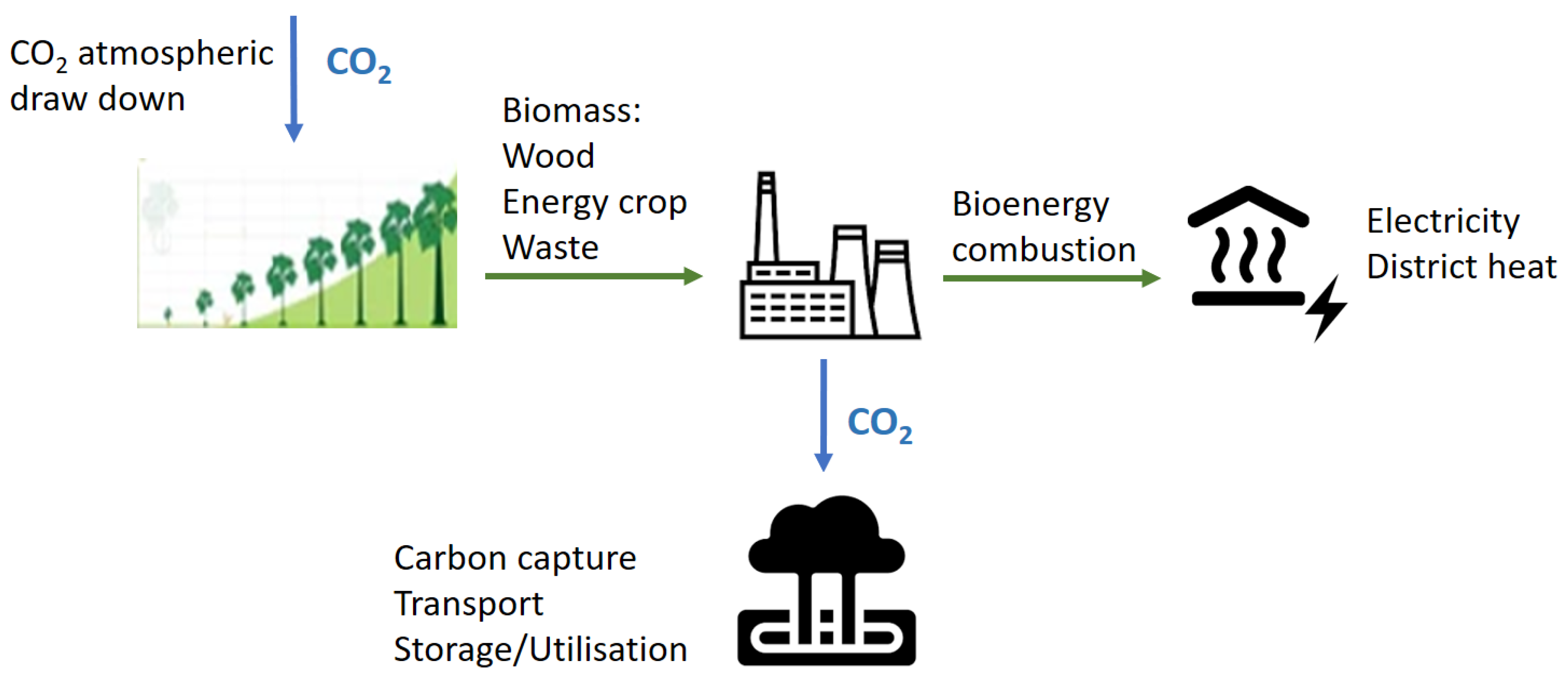
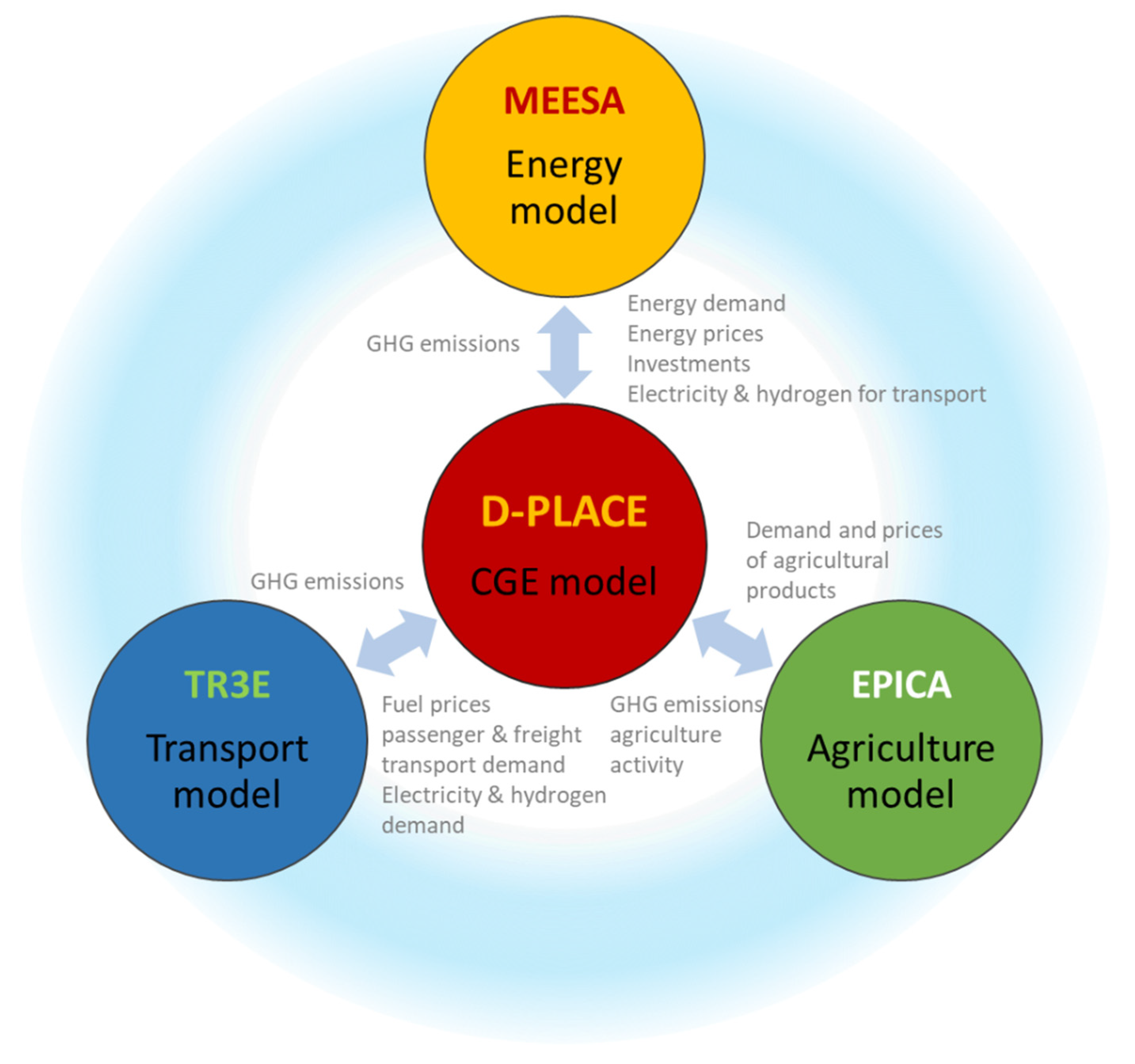
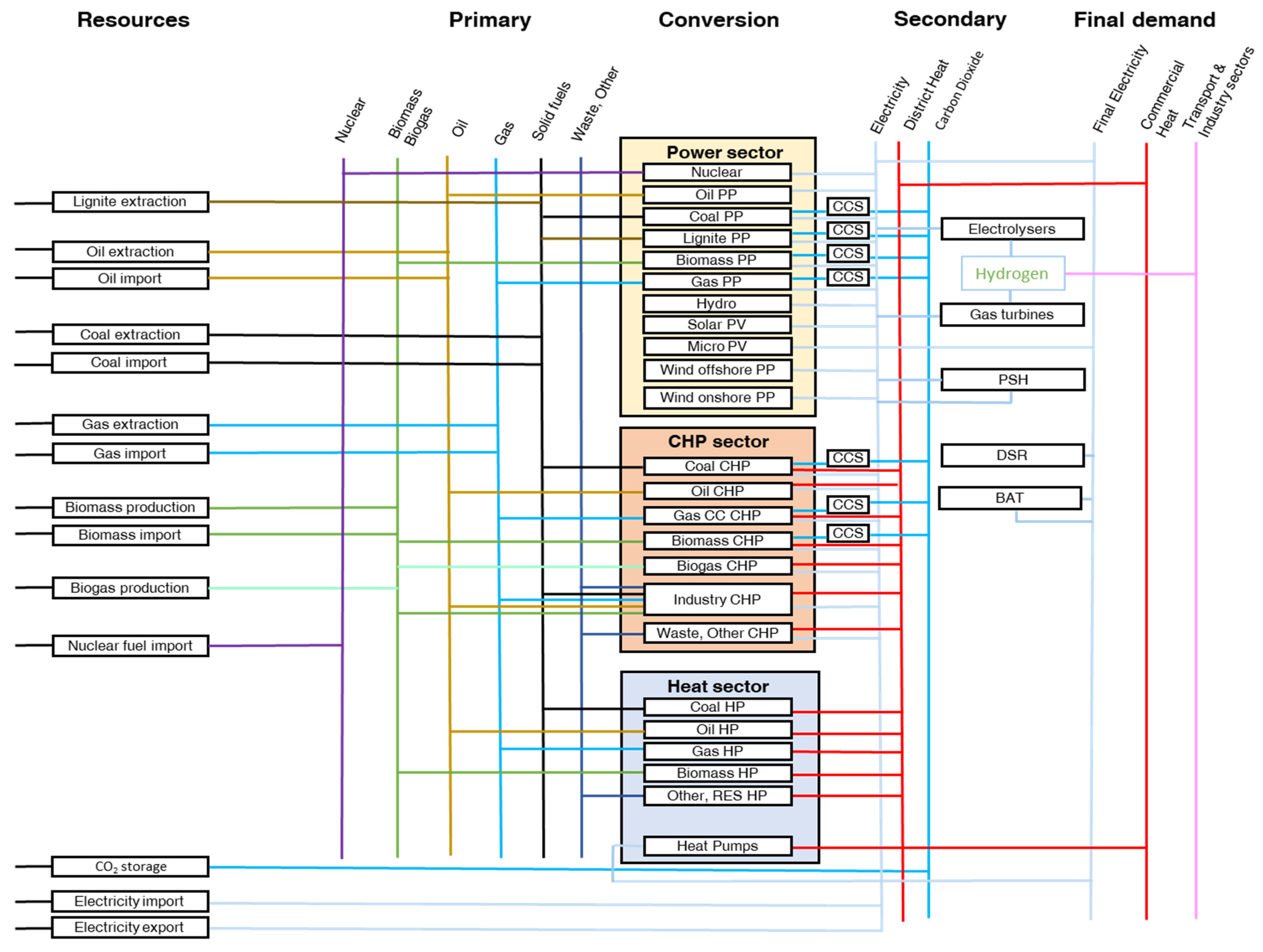
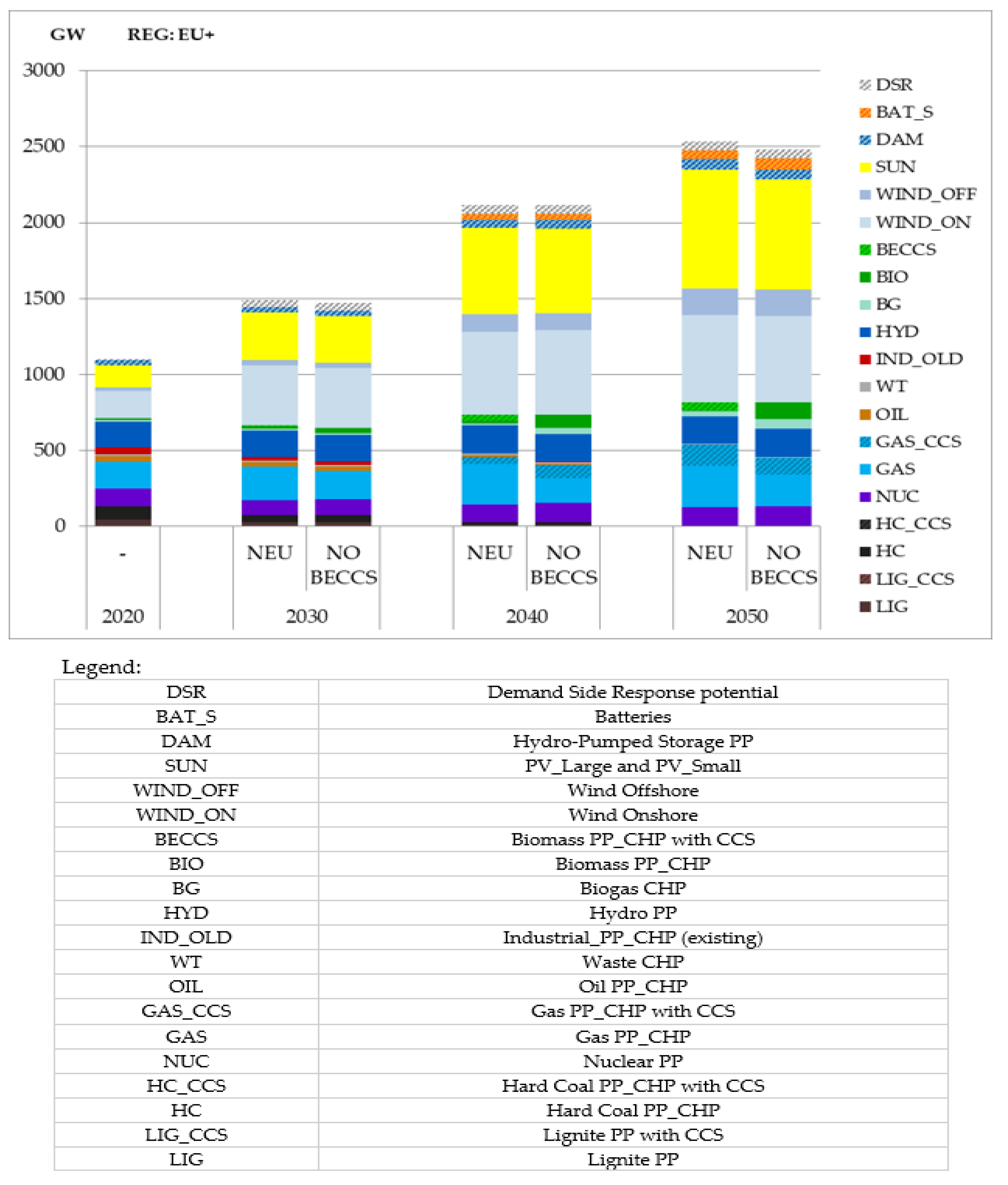
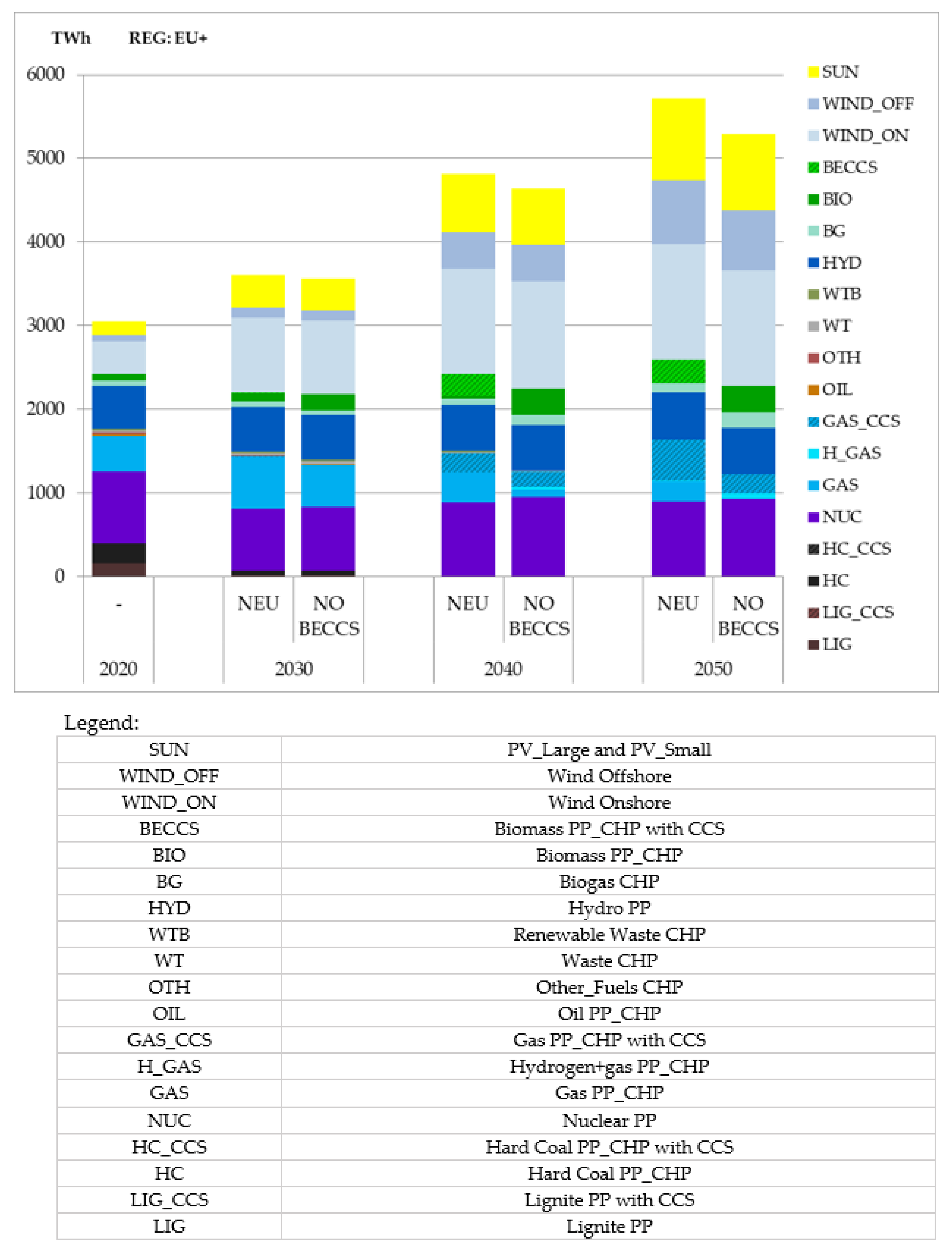
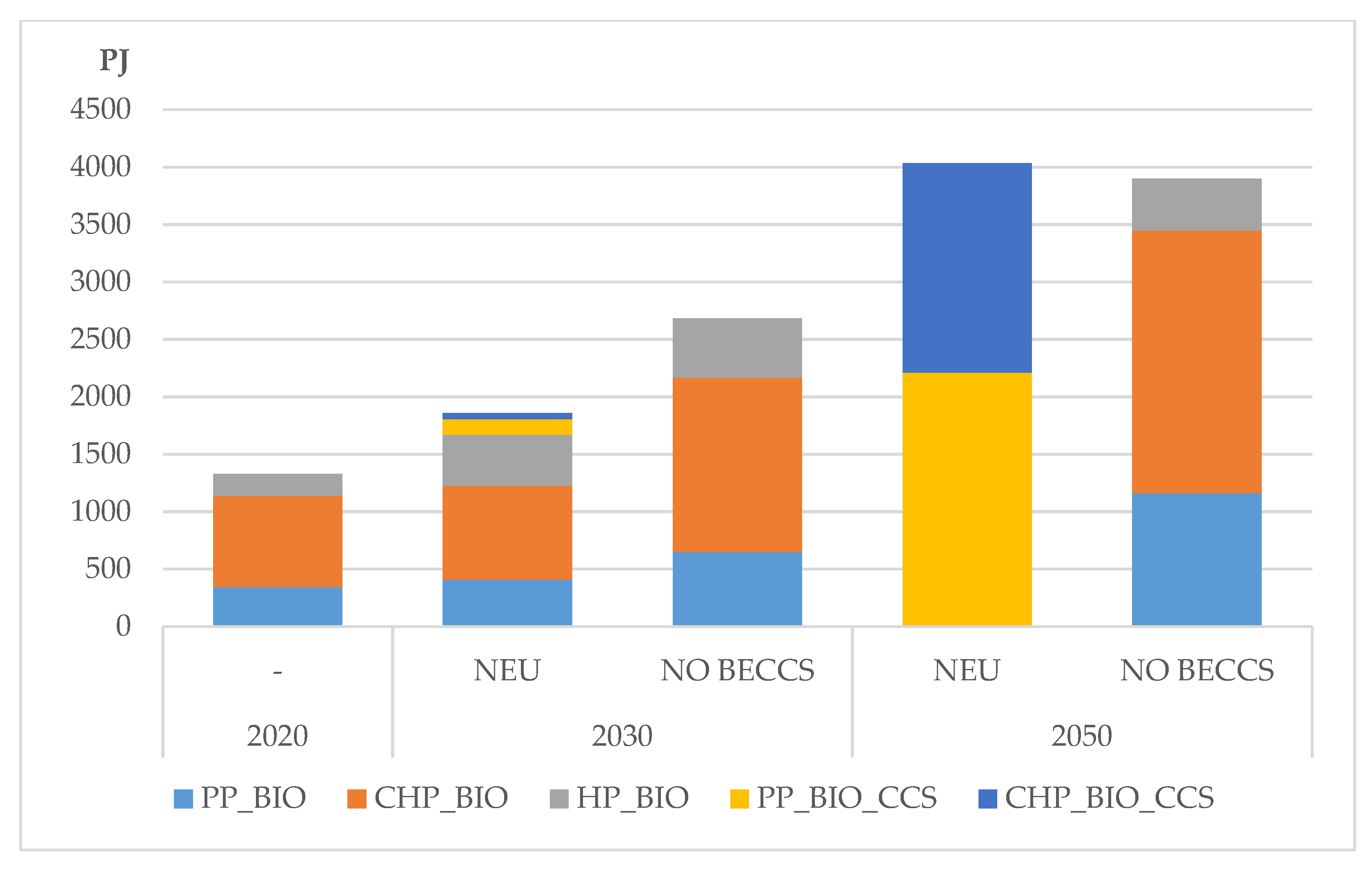


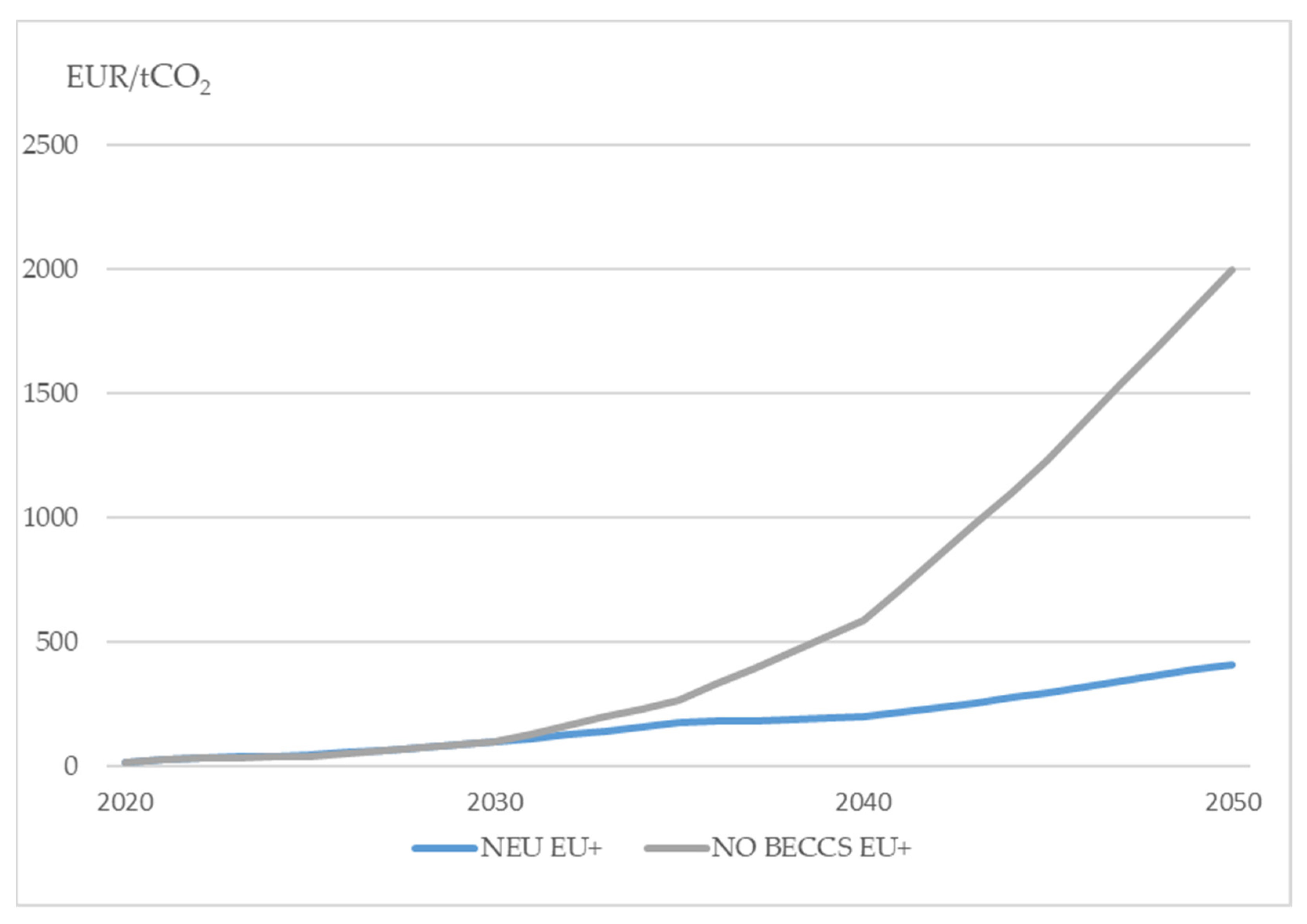

| Technology | Overnight Investment Cost *, EUR/kW | Fixed Operation and Maintenance Cost, EUR/kWyr | Variable Cost, EUR/MWh | Electrical Efficiency (Net) in Optimal Load Operation, Ratio | Technical Lifetime, Years | ||||||||
|---|---|---|---|---|---|---|---|---|---|---|---|---|---|
| 2030 | 2040 | 2050 | 2030 | 2040 | 2050 | 2030 | 2040 | 2050 | 2030 | 2040 | 2050 | ||
| BECCS_PP | 3700 | 3300 | 3200 | 69 | 63 | 61 | 5.9 | 5.8 | 5.8 | 0.31 | 0.32 | 0.32 | 40 |
| BECCS_CHP | 5000 | 4500 | 4300 | 93 | 85 | 82 | 8.0 | 7.8 | 7.8 | 0.25 | 0.26 | 0.26 | 40 |
| Biomass_PP | 1800 | 1700 | 1700 | 40 | 39 | 38 | 3.6 | 3.6 | 3.6 | 0.39 | 0.40 | 0.40 | 40 |
| Biomass_CHP | 2450 | 2300 | 2300 | 54 | 53 | 52 | 4.9 | 4.9 | 4.9 | 0.30 | 0.30 | 0.30 | 30 |
| Gas_PP | 580 | 575 | 570 | 21 | 20 | 19 | 1.9 | 1.8 | 1.7 | 0.61 | 0.62 | 0.63 | 30 |
| GAS_CHP | 780 | 775 | 770 | 28 | 27 | 26 | 2.6 | 2.4 | 2.3 | 0.48 | 0.48 | 0.48 | 30 |
| GAS_PP_CCS | 1625 | 1500 | 1500 | 38 | 35 | 34 | 3.0 | 2.9 | 2.8 | 0.50 | 0.50 | 0.50 | 30 |
| GAS_CHP_CCS | 2200 | 2025 | 2025 | 52 | 47 | 46 | 4.1 | 3.9 | 3.8 | 0.32 | 0.32 | 0.32 | 30 |
| Lignite_PP_CCS | 3340 | 3250 | 3150 | 65 | 62 | 61 | 5.1 | 3.6 | 3.4 | 0.33 | 0.34 | 0.35 | 40 |
| Coal_PP_CCS | 3150 | 2890 | 2850 | 65 | 56 | 54 | 5.0 | 4.8 | 4.8 | 0.37 | 0.38 | 0.38 | 40 |
| Biogas | 465 | 458 | 450 | 24 | 24 | 23 | 2.6 | 2.6 | 2.6 | 0.38 | 0.39 | 0.39 | 25 |
| Nuclear | 5100 | 4900 | 4700 | 115 | 108 | 105 | 7.4 | 7.6 | 7.8 | 0.38 | 0.38 | 0.38 | 60 |
| Wind—onshore | 1175 | 1150 | 1100 | 13 | 12 | 12 | 0.2 | 0.2 | 0.2 | 1.00 | 1.00 | 1.00 | 30 |
| Wind—offshore | 1650 | 1577 | 1503 | 27 | 26 | 26 | 0.4 | 0.4 | 0.4 | 1.00 | 1.00 | 1.00 | 30 |
| Solar PV | 551 | 529 | 507 | 15 | 11 | 9 | 0.0 | 0.0 | 0.0 | 1.00 | 1.00 | 1.00 | 30 |
| Solar PV small | 543 | 522 | 500 | 15 | 11 | 9 | 0.0 | 0.0 | 0.0 | 1.00 | 1.00 | 1.00 | 30 |
| Hydro | 1670 | 1660 | 1650 | 8 | 8 | 8 | 0.0 | 0.0 | 0.0 | 1.00 | 1.00 | 1.00 | 50 |
Publisher’s Note: MDPI stays neutral with regard to jurisdictional claims in published maps and institutional affiliations. |
© 2021 by the authors. Licensee MDPI, Basel, Switzerland. This article is an open access article distributed under the terms and conditions of the Creative Commons Attribution (CC BY) license (https://creativecommons.org/licenses/by/4.0/).
Share and Cite
Tatarewicz, I.; Lewarski, M.; Skwierz, S.; Krupin, V.; Jeszke, R.; Pyrka, M.; Szczepański, K.; Sekuła, M. The Role of BECCS in Achieving Climate Neutrality in the European Union. Energies 2021, 14, 7842. https://doi.org/10.3390/en14237842
Tatarewicz I, Lewarski M, Skwierz S, Krupin V, Jeszke R, Pyrka M, Szczepański K, Sekuła M. The Role of BECCS in Achieving Climate Neutrality in the European Union. Energies. 2021; 14(23):7842. https://doi.org/10.3390/en14237842
Chicago/Turabian StyleTatarewicz, Igor, Michał Lewarski, Sławomir Skwierz, Vitaliy Krupin, Robert Jeszke, Maciej Pyrka, Krystian Szczepański, and Monika Sekuła. 2021. "The Role of BECCS in Achieving Climate Neutrality in the European Union" Energies 14, no. 23: 7842. https://doi.org/10.3390/en14237842
APA StyleTatarewicz, I., Lewarski, M., Skwierz, S., Krupin, V., Jeszke, R., Pyrka, M., Szczepański, K., & Sekuła, M. (2021). The Role of BECCS in Achieving Climate Neutrality in the European Union. Energies, 14(23), 7842. https://doi.org/10.3390/en14237842







